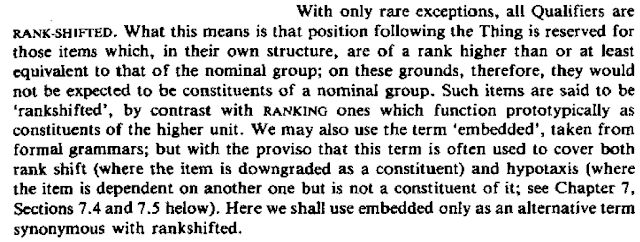10.1.2 The remaining traces of the concept of a 'rank scale' of 'units'
It would be surprising if the concept that was the backbone of Halliday's original theory of syntax were to disappear without trace from the theory proposed here. After all, the phenomena in language that led Halliday to recognise the concept in the first place are still there. We should ask, therefore, whether the concepts of 'unit' and 'rank', in Halliday's original senses of the terms, have any correlates in the framework of concepts proposed here. Let us examine this question for a moment.
Blogger Comments:
[1] To be clear, the validity of theorising is not a matter of whether or not it is 'surprising'.
[2] This is misleading, because it is untrue. The rank scale was not the 'backbone' of Halliday's superseded theory, Scale & Category Grammar. Halliday (2002 [1961]: 41):
The fundamental categories for the theory of grammar are four: unit, structure, class and system.
Traditionally these terms have usually referred to “grammar above the word” (syntax) and “grammar below the word” (morphology); but this distinction has no theoretical status. … But it seems worthwhile making use of “syntax” and “morphology” in the theory, to refer to direction on the rank scale. “Syntax” is then the downward relation, “morphology” the upward one; and both go all the way.
[4] To be clear, the theoretical question is how to model such phenomena to the best advantage.
[5] In anticipation of Fawcett's misunderstandings of Halliday's original senses of 'unit' and 'rank', it may be useful to cite Halliday's own words, as a point of departure. Halliday (2002 [1961]: 43):
The category set up to account for the stretches that carry grammatical patterns is the unit. The units of grammar form a hierarchy that is a taxonomy. To talk about any hierarchy, we need a conversational scale; the most appropriate here might seem that of size, going from “largest” to “smallest”; on the other hand size is difficult to represent in tables and diagrams, and may also trap one into thinking in substantial terms, and a vertical scale, from “highest” to “lowest”, has advantages here. For the moment we may use both, eventually preferring the latter. The relation among the units, then, is that, going from top (largest) to bottom (smallest), each consists of one, or of more than one, of the unit next below (next smaller). The scale on which the units are in fact ranged in the theory needs a name, and may be called rank.











